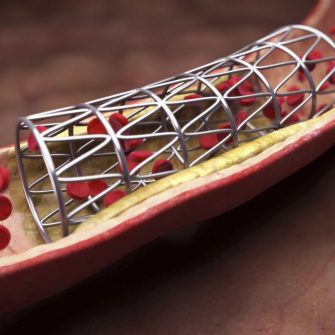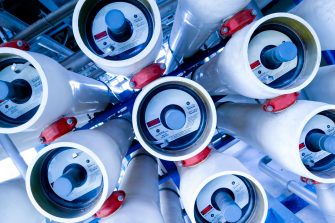Expanding solutions in dialysis treatment
Improving patient experience through new technologies and techniques for stenosed and stented arteries.

Share this story
Through her research in vascular fluid dynamics, Professor Tracie Barber and her collaborators at the Prince of Wales Hospital are impacting the treatment and outcomes of patients undergoing kidney failure dialysis. With vascular surgeons A/Prof. Ramon Varcoe and Dr Shannon Thomas, the team have developed new methodologies for surgical trainers and ultrasound imaging. These are ensuring better treatment, fewer complications and less hospital visits for patients.
Stent deployment into a model in the laboratory at UNSW.
Working closely with the clinical team, Professor Barber’s team started by considering whether they could change the geometry of the surgery that opens the arterio-venous fistula (the irregular connection between an artery and a vein) to help reduce negative impacts for patients undergoing treatment.
Traditionally, the way in which dialysis is delivered allows for faster blood flow and therefore less time in the chair, however, it can also lead to a host of unwanted issues and side effects. “Because you’re doing this very abnormal thing to the blood flow, the veins often block up, get stenosis and fail,” explains Professor Barber. “Dialysis patients are having to come back into hospital and have emergency surgery, or they can’t have dialysis because the flow is blocked, and you can’t put the needles in.”
With this in mind, Professor Barber and her team used computational models and experimental work in the lab to determine a better geometry for treatment. This initially proved difficult to apply surgically but spurred the creation of a new solution.
"We realised we could potentially do this with a new type of stent that’s not usually used in these situations. We now know if you can change the geometry, the best way to do it seems to be by using this particular stent called the Abbott "Supera”. The clinical results definitely show that it has a positive impact,” explains Prof. Barber.
The team has since seen their research successfully used in over 100 patients. “It’s a huge deal because it’s making the fistulas work much better,” adds Dr. Shannon Thomas. “It’s worked really well and has stopped some of the problems patients were experiencing.” The “Supera” stent is now being used around the world as a new technique for helping dialysis patients.
While the research can be applied to anyone undergoing dialysis, it’s also a highly personalised experience as Prof. Barber and her team engage directly with patients. “Every fortnight we scan patients with an ultrasound system we’ve also developed,” she explains. “We do this to get their exact geometries and then we create computational models with each patient to be able to work out what would be a good geometry for them specifically.”
A collaborative approach
Throughout the last 10 years, Professor Barber and her team have worked closely with doctors, clinicians and nurses to ensure their work was solving the right challenges. “When this idea first started, we literally walked into the dialysis unit at the hospital and asked to speak to a few nurses about the problems they were experiencing,” explains Professor Barber. “They mentioned a number of issues about needles, so we got to work.”
As more surgeons begin to adopt the new stenting techniques, it’s her hope that awareness of the work done at UNSW and Prince of Wales and the adoption of the research continues to grow.
“When I decided to move into the biomedical field, dialysis wasn’t really considered one of the ‘hot’ areas to look at despite there being so many problems. But it’s so nice to know that we’re now making an impact.”
- Professor Barber
Share this story
Read more
Get in touch and see what’s possible.
Ask how we can help your business, industry, or market through collaboration.



